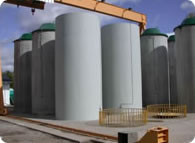Waste Management
Three types of liquid wastes are generated from the isotope recovery and waste solidification processes, of the NPF: fissile high-level liquid waste, non-fissile active liquid waste, and non-fissile low-level liquid waste. A shielded waste storage vault containing dedicated tanks for short-term storage of the liquid wastes before their solidification is located below the hot cells.
 |
| Above ground concrete canisters for storage of uranium solid waste materials |
The
fissile high-level liquid waste is sent to one of three tanks in the waste storage vault. After a suitable time period that allows the activity of the waste solution to decay, the waste is transferred to a calcination system in a hot cell to convert it into a stable form. The cans of calcined waste are assembled into baskets that are transferred in a shielded flask to concrete canisters in the CRL Waste Management Areas for safe, long-term dry storage.
Non-fissile active liquid waste generated from the isotope recovery and calcination processes is sent to one of two tanks in the waste storage vault. Similar to the high level waste, the non-fissile active liquid waste is transferred, after a suitable decay period, to a cementation system in a hot cell to be converted into a stable form. The cans of cemented waste are then transferred in a flask to the CRL Waste Management Areas for safe, long-term storage.
Non-fissile low-level liquid waste is sent to one of two tanks in the vault. After a suitable decay period, the non-fissile low-level liquid waste is sampled, analyzed and then discharged via the active drain system to the CRL Waste Treatment Centre for processing.